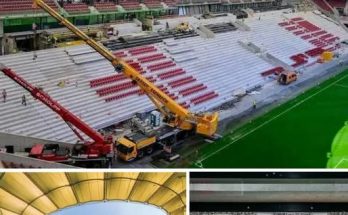In a move that sent seismic shockwaves through the sports world and the New York metropolitan area alike, James L. Dolan, the often polarizing owner of the New York Rangers and executive chairman and CEO of Madison Square Garden Sports Corp, delivered a bombshell update that has left fans, urban planners, historians, and sports media abuzz. Speaking at a high-security press conference that attracted a swarm of national attention, Dolan unveiled official blueprints, financial projections, and a narrative that is redefining the trajectory of sports infrastructure not only in the United States, but globally. Construction has officially commenced on a new Madison Square Garden Arena—described by Dolan as “the future coliseum of sports and entertainment”—with an unprecedented seating capacity that will exceed 100,000.
The project’s implications are monumental. To put this in perspective, the current Madison Square Garden, nestled between 7th and 8th Avenues in Manhattan, holds just under 20,000 spectators at full capacity. The idea of increasing that figure fivefold would be audacious anywhere, but in the dense urban core of New York City, it flirts with the realm of the impossible. And yet, according to Dolan and a coalition of architects, engineers, and economists brought to the stage alongside him, not only is it happening—it’s happening fast.
Construction will take place at a location not yet publicly disclosed in full detail due to ongoing negotiations with city and state agencies. However, Dolan confirmed that the new site will not stand on the current Garden’s footprint. Instead, it will be situated just a few blocks west of Hudson Yards, one of Manhattan’s most rapidly developing areas. This zone, once dominated by old rail yards, is quickly becoming a 21st-century urban landmark with luxury high-rises, retail centers, and corporate headquarters. It is here that Dolan envisions the new arena anchoring what he calls “the next great civilization center in the Western Hemisphere.”
The sheer scale of the project is staggering. The arena will be able to host more than 100,000 attendees for hockey games, basketball games, mega-concerts, political conventions, esports championships, and even global religious assemblies. To contextualize this scale, such capacity rivals that of the Michigan Stadium—commonly referred to as “The Big House”—which is the largest stadium in the United States with a capacity of approximately 107,000. However, unlike Michigan Stadium, which is open-air and used exclusively for college football, the new Madison Square Garden will be a fully enclosed, multi-use architectural marvel with modular seating systems and AI-driven crowd control technologies.
James Dolan has long been known as an owner willing to buck tradition and double down on disruptive innovation. Critics and supporters alike have acknowledged his role in transforming the original MSG into a tech-enhanced venue in the early 2010s. Yet, this announcement is not merely a continuation of his previous endeavors; it’s a paradigm shift. For many fans and stakeholders, the announcement was both exhilarating and emotionally jarring. The existing MSG has become part of the cultural fabric of New York City, hosting historic performances by the likes of Michael Jackson and Billy Joel, epic NBA and NHL moments, and serving as a backdrop to multiple generations of memories. To learn that a new venue would eclipse it both physically and symbolically triggered waves of nostalgia and unease.
Yet, Dolan insists that the new arena is not a replacement, but an evolution. “The existing Garden will continue to host events,” he stated firmly. “It is not being torn down. In fact, we envision it becoming more specialized, more intimate—serving as a premier venue for boutique experiences, mid-tier league events, and community-focused gatherings.” That being said, all Rangers and Knicks games are slated to transition to the new arena within three seasons, assuming construction proceeds on schedule.
Among the more controversial aspects of Dolan’s announcement is the estimated cost of the new facility—over $8.7 billion—an astronomical figure even in the world of luxury development. The funding will come from a mixture of private investment, municipal bonds, and what Dolan described as “innovative long-term revenue models,” including naming rights, high-tech advertising integration, and exclusive media rights. While no official naming rights partner has been revealed, rumors have already begun swirling about mega-corporations such as Amazon, Google, and Apple expressing interest.
The environmental and infrastructural implications of such a project cannot be overstated. A stadium of this size will demand unprecedented transportation access, emergency management coordination, and urban integration. Dolan addressed this head-on, introducing plans for a dedicated underground transit terminal connected to both Penn Station and the Hudson Yards subway stop. In addition, a massive above-ground concourse will include hotels, restaurants, high-end retail, and green spaces designed by some of the world’s foremost landscape architects.
Still, not everyone is applauding. Urban historians, community advocates, and sustainability experts have already expressed deep concerns. “Where will all these people go before and after games?” one city planner asked rhetorically. “How do you move over 100,000 people through midtown Manhattan without paralyzing the entire city?” There are also questions about energy usage, given the building’s size and expected 24/7 operations, and the displacement of lower-income communities if the surrounding area is aggressively gentrified.
In response to anticipated criticism, Dolan revealed the formation of an independent ethics and impact council comprised of environmental scientists, urban sociologists, community leaders, and former city officials to oversee the development process. He promised transparency and vowed to release quarterly progress and impact reports to the public. “We’re not just building for New York,” Dolan said with resolve. “We’re building for the world.”
The new Madison Square Garden’s design is reportedly being led by Foster + Partners, a world-renowned architecture firm known for structures like the Apple Campus and The Gherkin in London. Digital renderings revealed a sleek, elliptical structure cloaked in semi-transparent photovoltaic glass that shimmers with dynamic light changes depending on the time of day and event type. The building is engineered to adapt to atmospheric conditions, using energy-efficient HVAC systems and kinetic flooring that captures footstep energy to help power the stadium.
Perhaps the most futuristic feature is the arena’s integrated artificial intelligence system—nicknamed “Athena”—which will manage everything from real-time crowd density to bathroom traffic, food service predictions, and customized fan experiences. Attendees will be able to use a proprietary app to navigate the venue, order items to their seats, access instant replays from various camera angles, and even participate in crowd-based AR games.
For the Rangers organization, this announcement could mark the beginning of a new dynasty era. The team has been investing heavily in young talent, revamped coaching philosophies, and analytical infrastructure. Several players have already publicly voiced their excitement about the new facility, seeing it as a symbol of commitment to long-term success. Star center Mika Zibanejad called it “a dream you didn’t know you had until now,” while goalie Igor Shesterkin said, through a translator, that playing in such a venue “would be like defending a castle in a video game—giant, epic, surreal.”
Fans of the Rangers have had mixed reactions. Some are thrilled at the potential for world-class events, lower ticket scarcity, and enhanced amenities. Others worry about losing the gritty, blue-collar energy that defined the old Garden. Dolan acknowledged this divide and promised that the design team has spent extensive time studying fan culture to preserve those intangible elements that make MSG unique. “The chants, the organ, the buzz, the fear visiting teams feel—we are keeping all of that,” he said. “We’re not erasing history. We’re amplifying it.”
This development places New York City at the epicenter of the global sports venue conversation, surpassing plans for stadiums in Dubai, Tokyo, and Las Vegas. It also signals a renewed arms race among major franchises across all leagues to rethink the future of live events. With digital consumption rising and fan attention spans shrinking, arenas must now offer more than seats—they must offer sensory immersion, cultural relevance, and enduring legacy.
As construction crews begin initial excavation work, Dolan closed his press briefing with a line that has already gone viral across social media: “New York deserves something no one’s ever seen. This is not a rebuild. This is the beginning of a legend.” Whether that legend will live up to its hype or become a cautionary tale remains to be seen. But for now, one thing is certain: the new Madison Square Garden project is the most audacious and game-changing arena development in modern sports history.



